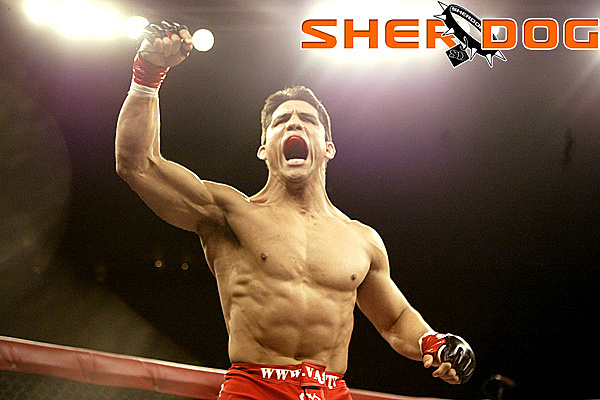A UFC Excursion Like No Other
MMA’s Mecca

Frank Shamrock (File Photo) remembers well his appearance at
‘Ultimate Brazil.’ | Photo: Jeff Sherwood
If MMA were a religion, its holiest sites would be spread throughout the world. Many of the traditional martial arts developed in the Far East, and, in the dojos and professional wrestling rings of Japan, mixed martial arts began to take hold as a concept decades ago. In America and England, in particular, catch wrestling encouraged its competitors to cross disciplines and develop a universal combat skill set. However, more so than Tokyo, Lancashire or Las Vegas, MMA’s Mecca might very well be located in Brazil.
In Belem, the Japanese master Mitsuyo Maeda taught Carlos Gracie the art of Brazilian jiu-jitsu. That discipline was passed down through the likes of Helio Gracie and Rickson Gracie before Royce Gracie introduced it to the American public at UFC 1 in 1993. As would later be demonstrated, the Gracies did not have a monopoly on MMA wisdom, but the story of Royce Gracie became the story of the UFC. The Ultimate Fighting Championship became MMA’s dominant stage, and, as such, the winding road towards today’s MMA is most often traced to the training centers of Brazil.
Advertisement
In the fall of 1998, the UFC was on the decline. Pay-per-view buy rates had gone down and the sport was under fire by politicians and cable providers. Far from the big lights and big cities of today, the UFC’s then parent company, Semaphore Entertainment Group, ran in unregulated and under-regulated sites in Alabama, Mississippi and Louisiana. Brazil was a natural fit for an event, and the UFC targeted the Ginasio da Portuguesa arena in Sao Paulo.
“I remember that place vividly,” Frank
Shamrock says. “It was somewhat decaying and falling down. It
was the first arena I’d been in that looked like a third world
country arena. The plaster was coming down. It was pretty
scary.”
UFC 134 will take place at Rio de Janeiro’s HSBC Arena, a state-of-the-art facility built in 2007 that will host the Summer Olympics in 2016. UFC 17.5 “Ultimate Brazil” did not have quite the same grandeur, but it was seen by a raucous crowd that reacted with enthusiasm to the proceedings. Many of the fighters on the card were also particularly enthusiastic to compete in front of the Brazilian fans. At that time, there was little money in the sport and most competitors fought for the love of the game. They knew the history of Brazilian vale tudo and wanted to be a part of it.
Jeremy
Horn File Photo
Horn submitted at UFC 17.5.
The first fight of the main card set the stage, as it was notable in two particular respects. First, it was clear from the onset that the crowd was more educated about fighting than many of the ones in America at the time. Second, there was nothing the fans were more passionate about than watching Brazilian fighters take on opponents from other countries.
When Horn, an American, came out, he was greeted with whistles and boos. Ebenezer Fontes Braga entered to loud cheers and chants of his name from his fellow Brazilians. Horn knew he was in hostile territory but did not consider it a potentially dangerous situation. It was only about a year after the infamous Renzo Gracie-Eugenio Tadeau riot, but Horn was hardly a fighter with a reputation for instigating trouble.
“When you’re in Brazil, it’s always a heated atmosphere,” Horn says. “It was a rowdy, rambunctious crowd. Now, I didn’t see any potential trouble, but they were definitely very excitable.”
Shamrock had seen both ends of the spectrum.
“I fought in Japan, which was very subdued,” he says. “The American crowds were very loud. The crowd in Brazil was the first crowd that kind of functioned as a unit. They were incredibly connected, singing songs, chanting together. I could tell it was a different cultural thing.”
The finish of the fight demonstrated that it was an audience familiar with the nuances of no-holds-barred fighting. The crowd began to cheer when Braga started to lock in a guillotine choke, and, as he cranked the hold, it grew ever louder. The moment Horn tapped, the fans exploded.
The Brazilian crowd’s response to Braga’s submission victory stood in stark contrast to the UFC’s previous event, UFC 17, where the American audience did not react to Carlos Newton locking in a triangle choke or Bob Gilstrap tapping out, and there still appeared to be some confusion as to what happened even after the fight was stopped. Submissions were no mystery to Brazilian fight fans by 1998.
By comparison to Braga-Horn, the crowd reacted negatively to the next two matchups between foreign fighters. Tsuyoshi Kosaka-Pete Williams was an entertaining ground battle, but the fans jeered both men, perhaps because the Rings mainstay and the Pancrase veteran did not utilize strikes on the ground, which were prohibited in those organizations. Mikey Burnett-Pat Miletich was a tight-grabbing bore that served as the impetus for the modern UFC rule prohibiting the grabbing of an opponent’s tights.
The atmosphere, however, turned around with a familiar formula: Brazil vs. America.
David “Tank” Abbott played the role of a villain at early UFC events, but, really, he was more of a hero to the fans when he fought. His cocky demeanor, heavy punches and outspoken persona fit in well with the early ethos of the UFC. One night he was decidedly not a crowd favorite was at UFC 17.5. He faced a young Marco Ruas protégé named Pedro Rizzo in front of the partisan Brazilian audience.
Finish Reading » “That’s the fight that turned fighting around in my mind. It made me realize that if I’m going to pick up a sword I better swing it.”








